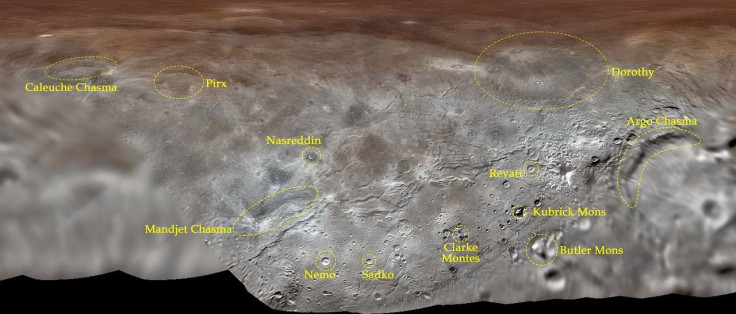Charon, Pluto's Biggest Moon, Has Some Interesting Names For Its Surface Features

Pluto sits several thousand miles away, but that doesn’t mean the scientific community has forgotten the tiny world. Just recently, International Astronomical Union (IAU), the body responsible for the nomenclature of celestial objects announced names for the surface features of Charon, the biggest moon of the icy planet.
A few years ago we had little to tell about Charon except it carries a neutral grey color tone, is half the size of Pluto and orbits the dwarf planet every 6.4 Earth days. But, all that changed in 2015 when NASA’s New Horizons spacecraft hurtled through Pluto’s neighborhood and captured the moon in unprecedented detail, Gizmodo reported.
The spacecraft came within 27,000 km of Charon and took a close look at its surface. The observation revealed many of the moon's previously unknown features such as craters, crevices, valleys, and mountains and now, some of them have been assigned fancy names, thanks to IAU’s Working Group for Planetary System Nomenclature.
The authority assigned 12 names in all, six to craters — Dorothy, Nasreddin, Nemo, Pirx, Revati, Sadko — and remaining to mountains and canyons, according to an IAU press release.
Most of the crater names come from folktales, novels, or narratives related to human exploration or travels to mysterious destinations in some way or the other. For instance, Nasreddin comes from a humor folktale popular in the Middle East, Southern Europe, and Asia; Dorothy recognizes the protagonist from the magical world of Oz novels, and Nemo represents the captain of the submarine featured in "Twenty Thousand Leagues Under the Sea" and "The Mysterious Island" novels.
Prix is also named after the main character featured in short stories from Stanislaw Lem, the person who travels between Earth, Moon, and Mars. Meanwhile, Revati and Sadko are from Hindu epic Mahabharata and medieval Russian epic Bylina. It is worth noting here that Charon's canyons, Argo, Caleuche, and Mandjet, also got their names from literary works and ancient folktales.
Names in honor of space exploration
IAU has also honored some distinguished personalities with its nomenclature strategy. Charon’s mountains — Butler Mons, Clarke Montes and Kubrick Mons — got their names from Octavia E. Butler, whose Xenogenesis trilogy describes humankind’s departure from Earth; writer Arthur C. Clarke, whose work gave imaginative depictions of space exploration, and film director Stanley Kubrick, whose iconic "2001: A Space Odyssey" tells the story of humans’ evolution into a spacefaring species.
Some of these names were proposed by the New Horizons team, while others came from the union’s OurPluto campaign, where people from different parts of the world were invited to give their suggestions. Next year, we could get some more names to cherish, as New Horizons will visit Ultima Thule or MU69, a distant object in the Kuiper Belt, on Jan. 1, 2019.
© Copyright IBTimes 2024. All rights reserved.



















